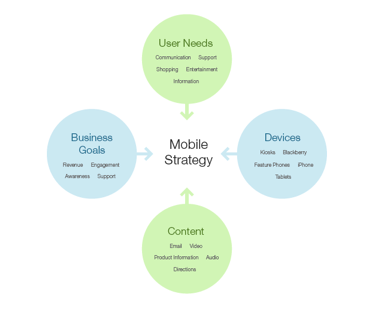The mobile web is poised to be big. Really big. Morgan Stanley estimated it’s going to be at least twice the size of the desktop/laptop Internet within five years. Gartner went further, predicting that mobile phones will overtake PCs as the most common web-access devices worldwide by 2013.
Innovative brands such as Apple and Zipcar are already achieving enormous success with mobile. In fact, a customer using Zipcar’s new iPhone app can have a highly successful relationship with the company without ever visiting its traditional website. The same can be said for Yelp, Netflix, and a growing list of other brands.
So why are so many organizations still waiting and watching from the sidelines, or coasting on their early forays into the medium? Perhaps they’re frozen in place by the enormity of the opportunity, or by the challenge of new and unfamiliar business models and technologies. Maybe they’re waiting for the market to mature. Maybe they don’t know this:
- 90% of the world now lives in a place with access to a mobile network.[*]
- Amazon.com sold more than $1 billion in products via mobile devices in 2010.[*] EBay generated $2 billion in mobile sales, including the sale of a $75,000 Corvette.[*]
- 37% of U.S. smartphone users have made a product purchase on their handsets in the last six months.[*]
- 13% of all U.S. consumers and 23% of the 18-34 age group make purchases via mobile four times a year.[*]
It’s time to get moving with mobile.
App or Website: Is That the Question?
When assessing their mobile business prospects, many organizations jump straight into the tactics:
“Should we build a mobile website or an app?”
“Augmented reality would be cool.”
“Are QR codes the way to go?”
“What’s a QR code?”
The key to a winning mobile presence is to identify your best business opportunities first, then choose the right tactics to support them based on what you can afford and what you can support.
Uncovering Your Mobile Opportunity
Defining your mobile strategy can feel like aiming at a moving target. Devices are constantly evolving, carriers are upgrading their infrastructure and offerings, people are adapting to new features and trends, and the media is forever hyping the next big thing.
But if you keep it simple and you keep it useful, your investment in mobile can pay for itself many times over in greater profitability, happier customers and new, previously unimaginable opportunities.
- Start with your business goals. When considering your mobile business strategy, always start with the business goals of your organization. How can a mobile presence help you achieve those goals? Will it improve your current reach? Will it open up new opportunities?
- Understand your audiences in the mobile context. Once you’re satisfied that you have a business opportunity with mobile, the next step is understand how your target audiences interact with their mobile devices and the context around them. Where do your audiences engage with mobile? What are they doing with it? At what time and place might they think of or need what you offer?
- Identify your target devices. With over 5,000 different devices on the market, you can’t design for all of them, so it’s important to identify which devices your audiences use the most and optimize your offering around them. Based on your findings, you might decide to start out slowly with a basic mobile website and text alerts, or you might go for broke with a rich experience across all of the major mobile platforms.
- Match your content to audience needs. The next step is to determine which of your content should be mobile. Simply having the content and the ability to make it mobile it is not enough on its own. Choose only the content that is most useful to your mobile audiences and takes into account how they behave differently from desktop users. Keep it simple. Limit choices. This results in a focused experience that cuts down the risk of your audiences becoming lost and frustrated.
- Study and leverage best practices. Chances are, your competitors and industry peers are already active in the mobile space. Analyzing their mobile experiences will help you to understand what the best practices are in your industry, what your customers have grown accustomed to, and how you can be unique.
Source: Modus Associates LLC
Are You Ready to Get Moving?
With almost 5 billion mobile handsets in use worldwide and capabilities improving daily, mobile may well be the greatest business opportunity of all time. You’ve got new skills to invest in, new technologies and platforms to understand, and new ways of thinking about your business and your customers. If you’re still waiting, falling behind, or in denial, it’s time to get moving with mobile.





